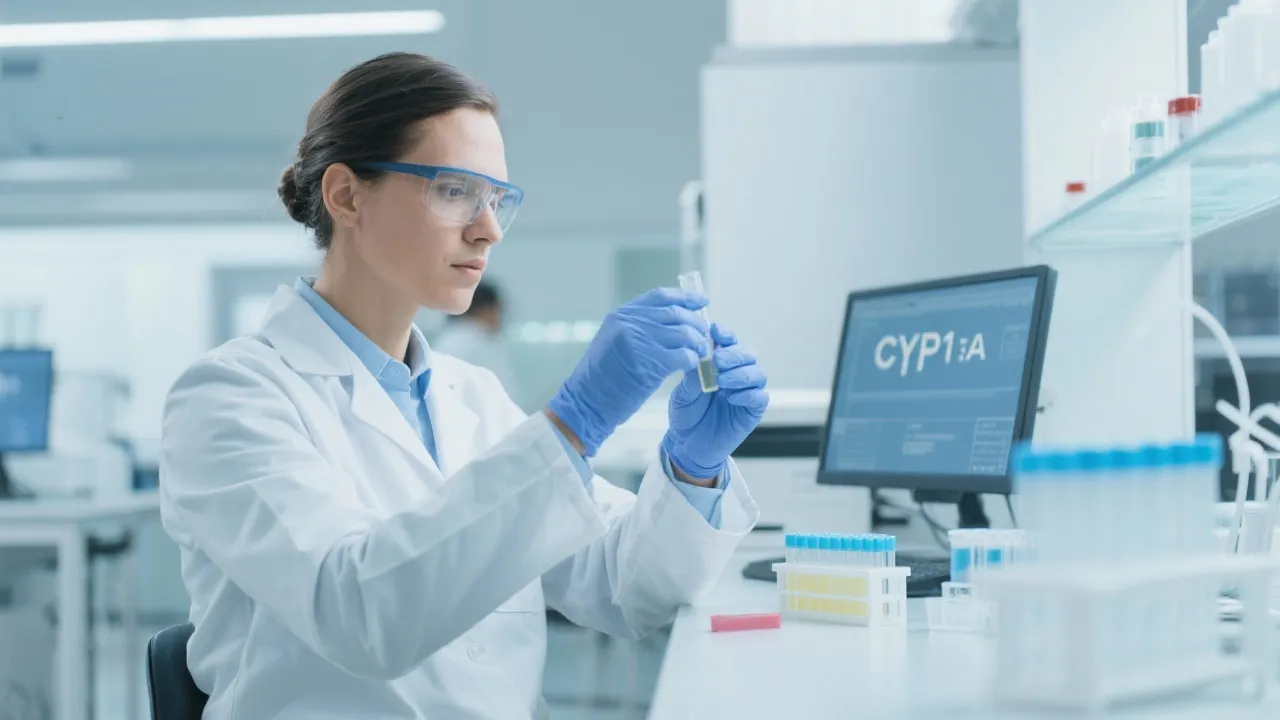Understanding the Cyp1a1 Assay
The Cyp1a1 assay plays a crucial role in toxicology and pharmacology by assessing the enzymatic activity of the cytochrome P450 1A1. This enzyme is instrumental in the metabolism of various compounds, including drugs and environmental toxins. Accurate Cyp1a1 assays are essential for understanding how these compounds interact with human biological systems, providing insights into their potential effects and safety.

Introduction to the Cyp1a1 Assay
In the realms of toxicology and pharmacology, the Cyp1a1 assay is a pivotal analytical tool deployed to evaluate the activity of the cytochrome P450 1A1 (CYP1A1) enzyme. This specific enzyme plays a significant role in metabolizing numerous drugs and xenobiotics, impacting how substances are processed in the human body. As researchers dive deeper into understanding these processes, the Cyp1a1 assay proves indispensable in assessing the safety and efficacy of various compounds. A thorough understanding of CYP1A1 not only aids in drug development but also contributes significantly to the field of personalized medicine, where treatments can be tailored based on a patient’s metabolic profile.
The Importance of Cyp1a1 in Drug Metabolism
The enzyme Cyp1a1, or cytochrome P450 1A1, is part of a larger family of enzymes responsible for the oxidative metabolism of both endogenic and exogenous substances. This enzyme's ability to process a variety of chemical substrates makes it a focal point in the study of drug interactions and detoxification pathways. Elevated or unusual activity of Cyp1a1 can influence the disposition of drugs, potentially leading to adverse drug reactions or therapeutic failures.
Moreover, CYP1A1 is particularly significant when discussing pro-carcinogens, which are substances that become carcinogenic only after being metabolically activated. For instance, certain polycyclic aromatic hydrocarbons (PAHs) can be metabolized by CYP1A1 into reactive intermediates that may interact with cellular macromolecules, leading to DNA damage and increased cancer risk. This illustrates the dual role of Cyp1a1 as both a facilitator of drug metabolism and a potential contributor to toxicological processes.
Conducting a Cyp1a1 Assay: A Step-by-Step Guide
For researchers and lab technicians aiming to conduct a Cyp1a1 assay, it’s imperative to understand each step of the process, ensuring accuracy and reliability in the results obtained. Below are the key steps involved:
- Sample Preparation: The initial stage involves preparing samples, which could be tissue homogenates, cell cultures, or microsomal fractions containing the enzyme under investigation. Effective preparation is critical, as the quality of samples directly influences the assay results. Ensuring that the samples are free from contaminants and that the enzyme is properly extracted will facilitate accurate measurements.
- Enzyme Reaction Setup: The next phase involves incubating these samples with specific substrates known to be metabolized by Cyp1a1, such as ethoxyresorufin or luciferin. The choice of substrate is crucial, as distinct substrates provide insights into the enzyme's activity under various conditions. Proper controls should also be set up to account for non-specific conversions and background signals.
- Measurement of Metabolic Activity: As the reaction proceeds, measuring the rate of substrate metabolism using methods such as fluorometry or high-performance liquid chromatography (HPLC) provides insight into the enzyme's activity under different experimental conditions. These readings allow for a better understanding of enzyme kinetics and the influence of various factors such as pH, temperature, and the presence of inhibitors or activators.
- Data Analysis: Quantifying the metabolites formed allows researchers to deduce the enzyme’s activity level, comparing it across different experimental setups. Advanced statistical analyses are often employed to validate the results and to establish any correlations with toxicity or efficacy measurements.
Comparing Cyp1a1 Assays: Techniques Used in Assays
| Technique | Pros | Cons |
|---|---|---|
| Fluorometric Assay | High sensitivity, rapid results, and ease of automation | Requires specialized equipment, potential interference from other fluorophores, and can be influenced by the cellular environment |
| Chromatographic Methods | High specificity, ability to separate complex mixtures, and quantification of multiple metabolites simultaneously | Time-consuming, costly relative to other methods, and requires skilled personnel for operation |
| Spectrophotometric Assay | Simple setup, cost-effective, and good for high-throughput screening | Lower sensitivity compared to other methods, and potential for overlap in absorbance spectra |
The Role of Cyp1a1 Assays in Toxicity Studies
Cyp1a1 assays provide a window into the detoxification pathways of various environmental pollutants. By observing how substances like polycyclic aromatic hydrocarbons (PAHs) are metabolized, researchers can infer potential risks these chemicals pose to human health. Such insights are vital for developing regulatory guidelines and health advisories related to environmental toxins.
Several studies have illustrated the connection between Cyp1a1 activity and the toxicity of various compounds. For instance, research has shown how increased Cyp1a1 expression correlates with enhanced metabolic activation of pro-carcinogens, leading to a greater incidence of cancer in exposed populations. Understanding this relationship can help in the assessment of risk and in the development of preventive measures.
Furthermore, the Cyp1a1 assay is essential in evaluating the effects of emerging contaminants, such as microplastics and pharmaceuticals found in wastewater. These substances may interact with biological systems differently than traditional pollutants, making it necessary to reassess toxicological paradigms based on CYP1A1 activity. By employing Cyp1a1 assays, researchers can explore the metabolic flexibility of various organisms and their adaptive responses to these modern threats.
FAQs
What is the function of Cyp1a1 in the human body?
Cyp1a1 is primarily involved in the metabolism of foreign substances. It aids in breaking down toxins and medications, converting them into less harmful metabolites that can be easily excreted. In addition, it is involved in the metabolism of some endogenous compounds, illustrating its broad biological significance.
Why is the Cyp1a1 assay important in pharmaceutical research?
By understanding how drugs are metabolized by Cyp1a1, pharmaceutical researchers can anticipate drug interactions, optimize dosing regimens, and improve the safety profiles of new therapeutics. The assay is especially critical in the context of personalized medicine, as individual variations in Cyp1a1 activity can influence therapeutic outcomes.
How does the Cyp1a1 enzyme affect drug efficacy?
The enzymatic activity of Cyp1a1 can influence the bioavailability of drugs. If a compound is rapidly metabolized, it might reduce its effectiveness, necessitating adjustments in dosage to achieve the desired therapeutic effect. Conversely, if a drug is metabolized too slowly, this may lead to toxicity or adverse effects due to drug accumulation. Understanding these dynamics helps in designing drugs and clinical protocols that optimize therapeutic efficacy while minimizing risk.
Are there any inhibitors of Cyp1a1 that researchers should be aware of?
Yes, several substances can inhibit Cyp1a1 activity, including some pharmaceuticals, environmental chemicals, and natural compounds like flavonoids. This inhibition can lead to increased blood levels of drugs that are normally metabolized by CYP1A1, resulting in potential toxicity or enhanced effects. Understanding the landscape of CYP1A1 inhibitors is vital for clinicians and researchers to prevent adverse drug reactions.
How can Cyp1a1 activity be measured in vitro and in vivo?
In vitro methods include the use of liver microsomes or isolated hepatocytes to measure CYP1A1 activity with the help of specific substrates. For in vivo assessments, researchers often analyze the levels of CYP1A1-related metabolites in biological fluids such as blood or urine after administering a particular substrate, providing real-time data on metabolic activity within the living organism. These methods can be complemented with genetic studies involving polymorphisms in the CYP1A1 gene, influencing enzyme expression and activity.
Future Directions and Innovations in Cyp1a1 Research
The future of Cyp1a1 research appears promising, particularly as technology advances and the need for safer and more effective therapeutic options grows. Upcoming areas of interest encompass:
- Genetic Variability: As we expand our understanding of pharmacogenomics, studies focusing on the genetic polymorphisms of CYP1A1 will enhance our knowledge of interindividual variability in drug metabolism. Understanding these genetic variations can inform personalized medicine approaches to improve therapeutic outcomes.
- Aging and Cyp1a1 Activity: Research into how aging affects CYP1A1 activity is essential. Aging can lead to altered metabolic responses, impacting drug efficacy and safety. Understanding these changes is crucial in geriatric pharmacotherapy.
- Environmental Interactions: As environmental pollutants continue to pose health risks, it will be relevant to explore the interactions of these substrates with CYP1A1. This research can aid in understanding their metabolism and toxicology, leading to better regulatory measures.
- Biomonitoring and Personalized Approaches: Advancements in biomonitoring techniques may allow for more comprehensive monitoring of Cyp1a1 activity in individuals, paving the way for tailored therapeutic regimens that take into account individual metabolic profiles.
- Development of Novel Inhibitors: The pursuit of selective Cyp1a1 inhibitors could provide new tools for researchers, allowing exploration of therapeutic applications focused on cancer and other diseases influenced by CYP1A1 activity.
Conclusion
The Cyp1a1 assay is a cornerstone of both toxicological assessments and pharmacological research, providing a deeper understanding of how substances interact within biological systems. As the global landscape of chemical usage and drug development continues to evolve, the insights gleaned from such assays will remain crucial, guiding safe and effective utilization of compounds across industries. Furthermore, continuous breakthroughs in methodologies, coupled with interdisciplinary collaboration in fields ranging from genomics to environmental science, will enhance the power of Cyp1a1 assays and their applications in improving public health and safety.





